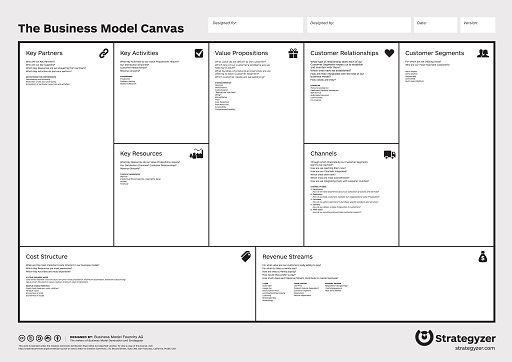2 The Business Model Canvas
One of the most accessible and straightforward approaches to developing, analysing and understanding a business model is the Business Model Canvas (Figure 2).

(Note: If you are viewing the Business Model Canvas PDF on screen then zooming is required for readability. If you are printing this PDF then A3 size or larger is recommended.)
The Business Model Canvas approach was developed by Alexander Osterwalder (2012) and can be applied to organisations of any size, type or sector. It describes an organisation and its functioning in terms of nine specific areas:
Customer segments – the customer and market segments you serve.
Value propositions – how you solve customer problems and satisfy their needs.
Channels – how you deliver your unique value proposition to customers, including communication, distribution and sales channels, among others.
Customer relationships – how you maintain relationships with customers and customer segments and the types of relationship you have.
Revenue streams – income and revenue from the sale of your product, service or idea.
Key resources – the most important resources required to deliver your unique proposition to the market.
Key activities – what you actually do as a business in order to generate revenue streams and deliver your offer to the market.
Key partners – who you partner with outside the business in order to deliver your proposition, e.g. suppliers, distributors, etc.
Cost structure – the costs you incur and the way your costs are structured and managed.
(For more detail see Osterwalder and Pigneur, 2010.)
Activity 1 The role of the Business Model Canvas
In this 3-minute video clip (Stanford eCorner, 2012), Alexander Osterwalder, creator of the Business Model Canvas, explains how it all fits together:
As you are watching, reflect on your business or a business you are familiar with. Can you see how each of the nine areas of the Business Model Canvas has a role to play in supporting business success?
Discussion
An important issue to consider is that the information inserted in the categories of the canvas are coherent. This is a critical issue that affects the credibility of your business model and the feasibility of your entrepreneurial idea.
For example, if the channel chosen to target your key customers is not appropriate, your business model will be questioned. Using internet sales to target people who don’t use the internet means that your idea does not address your customers’ actual needs. In addition, costs and revenues that are not balanced mean that your business will not be financially sustainable, hence putting your venture at risk.
1 What is a business model?
